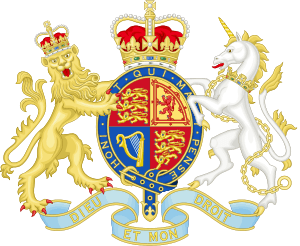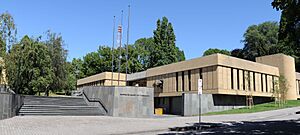Supreme Court of Tasmania facts for kids
Quick facts for kids Supreme Court of Tasmania |
|
|---|---|

The Royal Arms used by the Supreme Court of Tasmania
|
|

Supreme Court of Tasmania building, Hobart
|
|
| Established | 10 May 1824 |
| Jurisdiction | |
| Location | Hobart |
| Coordinates | 42°53′10″S 147°19′46″E / 42.886048°S 147.329556°E |
| Composition method | Vice-regal appointment upon Premier's nomination, following advice of the Attorney General and the Cabinet |
| Authorized by | Parliament of Tasmania via the: |
| Appeals to | High Court of Australia |
| Appeals from | Magistrates' Court of Tasmania |
| Judge term length | Mandatory retirement by age of 75 |
| Number of positions | 7 |
| Chief Justice of Tasmania | |
| Currently | Chris Shanahan |
| Since | 8 April 2013 |
The Supreme Court of Tasmania is the most important State court in the Australian State of Tasmania. It works with the Magistrates Court to form Tasmania's judiciary (the system of courts and judges).
This court is in the middle of the Australian court hierarchy. It can hear appeals from lower courts. Its own decisions can be appealed to the High Court of Australia, which is the highest court in the country.
The court usually meets in Hobart, Launceston, and Burnie. However, the Appeal Division, which handles appeals, only meets in Hobart.
Contents
Court's Beginning: A Look at History
The Supreme Court of Tasmania started a long time ago. It was first called the Supreme Court of Van Diemen's Land. This was the name for Tasmania back then.
The court officially began on 10 May 1824. This makes it the oldest Supreme Court in Australia. It even started ten days before the Supreme Court of New South Wales!
These early courts also had power over New Zealand. Sir John Pedder was the very first Chief Justice (the main judge) of the court. A famous lake, Lake Pedder, is named after him.
The first lawyer to work in the court was Joseph Tice Gellibrand. He became Tasmania's first Attorney-General (the chief legal officer).
The first case heard by the court was about William Tibbs. He was found guilty of a serious crime and was sent away as punishment for three years.
Discovering Old Laws
A librarian named Dorothy Shea worked at the court for many years. She found original copies of many Tasmanian laws. Some of these laws dated all the way back to 1833!
Dorothy led a project to fix and move these old laws to the Tasmanian Archive and Heritage Office. This important project was finished in 2024.
What the Court Does: Its Jurisdiction
The Supreme Court has full power within Tasmania for civil cases. These are disputes between people or groups. It also hears the most serious criminal cases.
The court has two main parts: the Trial Division and the Appeal Division. The Trial Division hears cases for the first time. The Appeal Division reviews decisions made by lower courts or by the Trial Division.
When the Appeal Division hears civil cases, it's called the "Full Court." For criminal cases, it's known as the "Tasmanian Court of Criminal Appeal."
Appeals to Higher Courts
If someone disagrees with a decision from the Appeal Division, they can appeal to the High Court of Australia.
Before 1986, some appeals could even go to a court in London called the Judicial Committee of the Privy Council. But now, all appeals from Australian courts go to the High Court of Australia.
Less serious civil cases, or disputes involving smaller amounts of money (less than $50,000), are usually handled by the Magistrates Court.
The Supreme Court also hears appeals from the Magistrates Courts in Tasmania. This includes both criminal and civil matters.
Unlike some other Australian states, Tasmania does not have a court in between the Supreme Court and the Magistrates Courts.
Who Works There: The Judges
The Supreme Court of Tasmania has up to seven judges. The Governor appoints these judges. This happens after advice from senior government ministers, including the Premier.
Currently, the judges of the Supreme Court of Tasmania are:
| Justice | Position | Commenced |
|---|---|---|
| Chief Justice | Chris Shanahan | 2025 |
| Justice | Helen Wood | 2009 |
| Justice | Stephen Estcourt | 2013 |
| Justice | Robert Pearce | 2013 |
| Justice | Michael Brett | 2016 |
| Justice | Tamara Jago | 2021 |
| Justice | Kate Cuthbertson | 2025 |
| Associate Justice | Michael Daly | 2024 |
The Associate Judge helps with many of the court's procedures. They also help decide how much money should be paid in some civil cases.
Images for kids
See also
- Judiciary of Australia
- List of Judges of the Supreme Court of Tasmania
- List of Tasmanian Supreme Court cases



